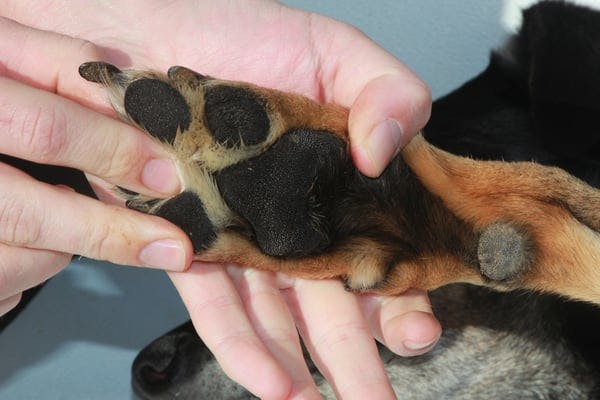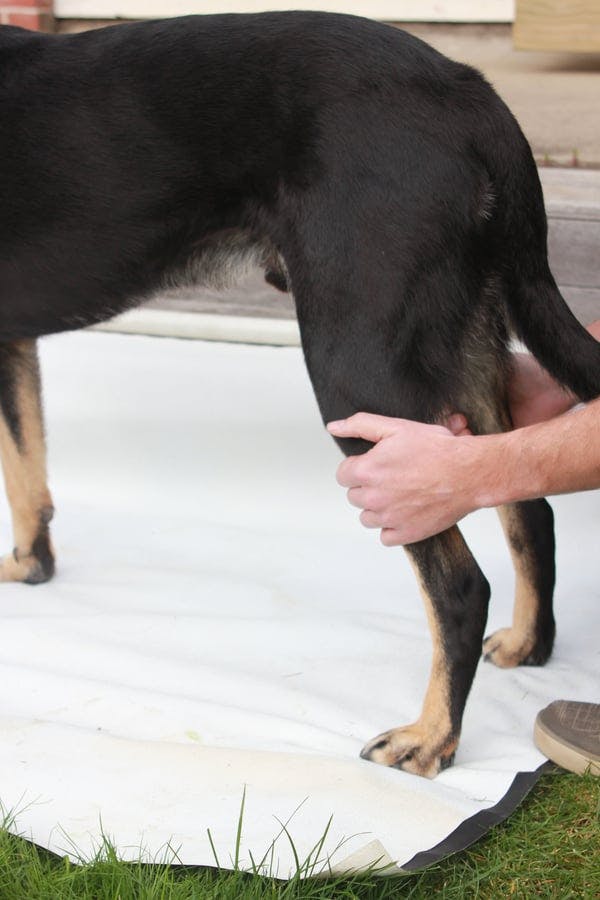
How to Examine your Dog's Legs for Lameness, Arthritis and more
General Advice
Dog
Health and Wellbeing
05/05/2023
It’s good to know how to examine your dog, especially the limbs, whether for lameness or arthritis, or just to get to know the anatomy a bit better.
How to examine your dog for lameness
Front legs carry the most weight, including the head and chest, so are the most important. Many people think lameness in the shoulder is due to a certain way a dog may walk, but this is not the case – foot lameness can look just the same as shoulder or elbow lameness.
Lameness is always caused by pain, except in very limited circumstances such as nerve damage. So if your dog is lame, it’s in pain. Dogs also hide their pain very well, so if it is limping, then you know they really are sore.
The best way to see lameness is with a dog at the trot on a lead, so it may be a two person job, one to do the leading, and one to look. Swap positions so both people can give an opinion.
The head may bob down as they step on a sore limb, and they will ‘short step’ on a leg they don’t want to put on the ground for long.
Most long term problems vets see are located in the elbow and hip and injuries are usually in the stifle – the dog’s knee on the hind legs – often with long term implications. But any part of a limb that is sore can cause lameness.
Feet
Have a good look at all the toenails, are they tidy and short, none sticking out at strange angles or broken at the base? No infection or discharge around the base of the nails, none split and no pain when you wiggle the nail around? Squeeze all the individual pads and look at the surface of them, are they smooth, rough, any cuts, ulcers or evidence of a foreign body such as glass or a thorn that may have gone in? There are four digital pads, one for each toe on the ground, and the stopper pad, which is the main pad they stand on (or the brake pad as you may like to call it!). Have a look and feel between each toe and underneath the foot, between the pads.
All dogs have hair between their pads and some long-haired dogs can get a solid matt of hair and dirt between them that causes pain. Sometimes grass seeds can get caught in the long hair between toes and can work their way into the foot. I have spent many hours digging grass seeds from between the toes of spaniels!

Dog Leg
Squeeze each joint in the toes and make sure they are all the same and there is no swelling or pain around any of them (there are three joints in each toe). We often see thickening around the toes in old arthritic dogs.
Feel the bones above the toes, at the ‘wrist’ – can you bend the wrist easily back and forth with no pain or is there swelling around the joint or pain/crunching?
Take note of your dog licking around their foot joints as this can be an indication of pain from arthritis.
Toes: Check the toenails are tidy and squeeze the toe joints to make sure there is no swelling or pain
Clean toes: Feel between the toes, checking they are clean and there aren’t any for seeds or dirt that could make it uncomfortable for your dog to walk
Pads: Check the pads for cuts, ulcers or thorns
Wrist: Feel the bones at the wrist and check it can bend easily without pain
Elbows and shoulders
Stand your dog square and from the front feel both elbows, checking that each knob and bump matches up with the other side. There shouldn’t be any soft bulges around the joints that may indicate inflammation.
Bend and stretch the elbow, the elbow should fully extend to almost 180 degrees without pain and should be able to close fully in most dogs. Make sure there is no crepitus (crunching).
Feel around for the shoulder joint – it’s hard to isolate this joint because the elbow moves as well – and check for any unusual soft bulges that indicate swelling.
Front check: Feel both front legs match up
Shoulder, Elbow: You should be able to bend the elbow and stretch it out to almost 180 degrees without pain
Ankle and knees
The ankle (hock) and knee (stifle) are hard areas to look at if you haven’t had much practice, but you can still do a basic check-up of both.
Crouch behind the dog and stand the legs square, feel both hocks and stifles for symmetry. Do all the bumps and lumps match up? Do they feel any pain when you push around on either side or bend and stretch the joints? Is there any crunching or strange clicking when feeling around? If your dog suddenly stops carrying weight on a back leg, then over a few minutes or seconds gives it a quick flick and it appears fine again, this may indicate a luxating patella, where the patella has moved sideways and caused the leg to lock up. This may need veterinary treatment.
The hock is made up of many little bones and any one of them can sometimes cause a problem. Ligament and tendon injuries are very common in the hock and stifle. In the hock, the Achilles tendon attaches at the back of the leg up to the muscle at the back of the knee. You can feel down this tendon, flex the hock back and forth and compare both legs, paying special attention to where the tendon attaches at the point of the hock.
The cranial cruciate ligament is the main one that holds the stifle in position, without it functioning normally, the dog will usually be very lame, often only toe touching. This ligament is one of the most common ones to get injured and causes varying degrees of lameness from weight avoidance to just slightly lame.
Knee check, Ankle check: Check the rear legs for symmetry at the stifle (knee) and hock (ankle)
Tendon check: The Achilles tendon is often easily injured – feel for pain and symmetry
Hips
Standing behind your dog you can put your left hand on the back just above the tail and hold the front of the right hind knee, stretching the whole hind leg out backwards. Most dogs can easily get each leg almost 180 degrees behind it. Any lack of movement may indicate hip problems. Most healthy hips shouldn’t crunch or creak. This shouldn’t cause any pain, so if your dog yelps while you do this it may be an indication to see a vet.
Swap hands and feel the left hip. Pushing gently over the pelvis and hip bones shouldn’t cause pain or discomfort and neither should gently pushing down with your thumb and index finger on either side of the spine.
Check for symmetry, every part of the right front leg should look and feel the same as the left, and vice versa for the back legs. Make sure you are familiar with the way all the main bones feel, you can even gently press over the long bones to feel for pain in them. The long bones consist of the femur (from hip to knee) and tibia (from knee to ankle) in the hind leg, and the humerus (from shoulder to elbow) and radius (from elbow to wrist) in the front leg.

Dog Leg
Any strange lumps or bumps in the skin itself need to be removed early on as these can grow in size.
Hips: Put your hand on your dog’s back and extend his rear legs one at a time to nearly 180 degrees – a lack of movement may indicate hip problems
Symmetry: Check for symmetry – every part of the front and rear left legs should feel the same as the right legs
Limping dog – see the vet!
Remember to always take your dog to the vet if you see they are lame. I have seen dogs with broken legs being left for a couple of days just because the owner thought it may be a muscle strain!

Written by The Pet.co.nz
Team
Written by The Pet.co.nz Team
A team of specialists with backgrounds in animal nursing, animal care, and all things pet related.